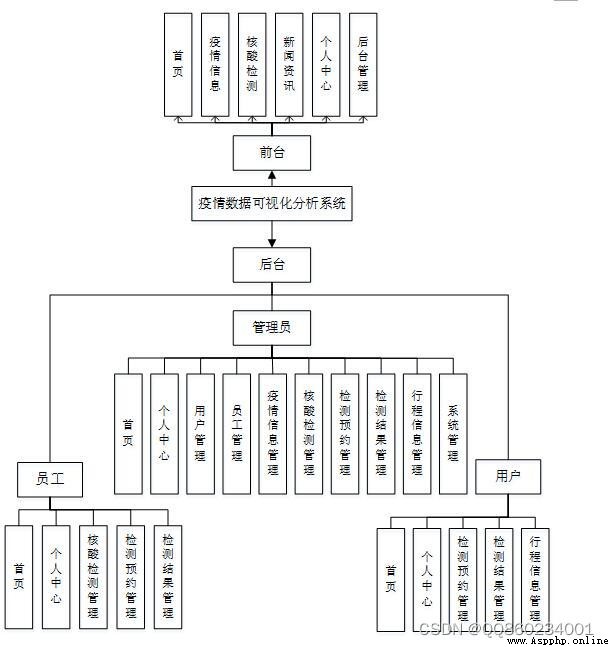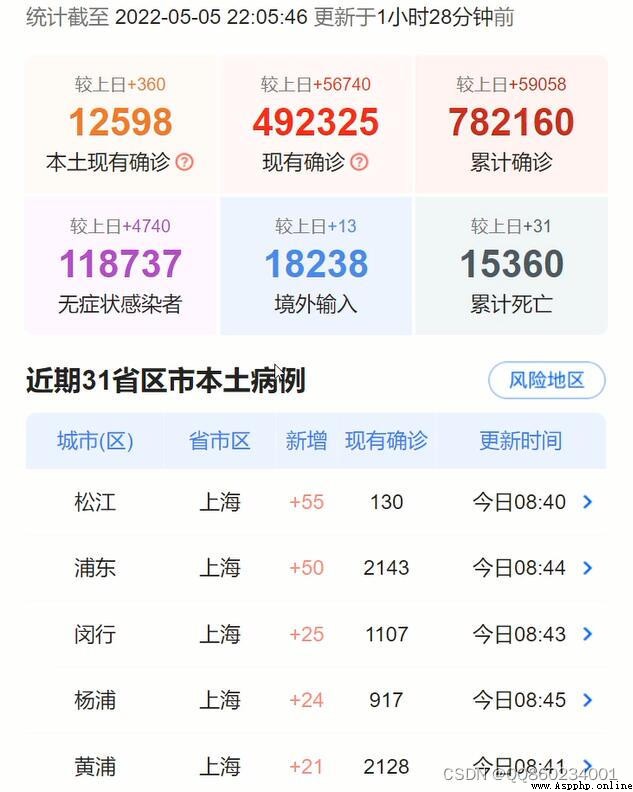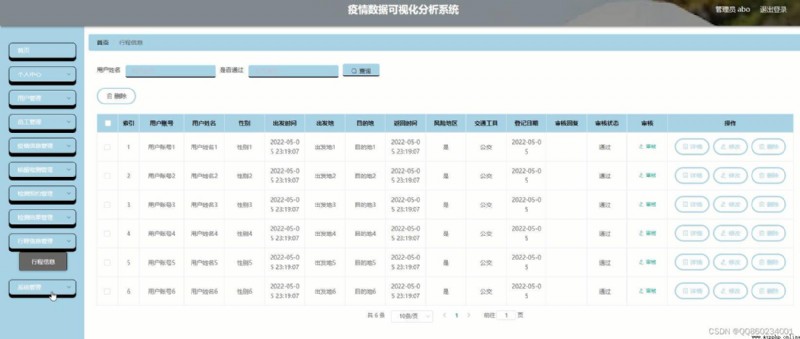疫情數據可視化分析系統采用Django框架,基於mysql開發,實現了首頁、個人中心、用戶管理、員工管理、疫情信息管理、核酸檢測管理、檢測預約管理、檢測結果管理、行程信息管理、系統管理等內容進行管理,本系統具有良好的兼容性和適應性,為用戶提供更多的疫情數據可視化分析信息,也提供了良好的平台,從而提高系統的核心競爭力.

Through the analysis of the function in front of the epidemic data visualization analysis system function can be divided into administrator、Employees and users three parts,系統的主要功能包括首頁、個人中心、用戶管理、員工管理、疫情信息管理、核酸檢測管理、檢測預約管理、檢測結果管理、行程信息管理、系統管理等內容.Any user as long as don't need to login into the system also can browse the information,Background management for logged-in users see satisfied with epidemic data visualization and analysis of information and design.
1、一般用戶的功能及權限
所謂一般用戶就是指還沒有注冊的過客,他們可以浏覽主頁面上的信息.但如果有中意的疫情數據可視化分析信息時,要登錄注冊,只有注冊成功才有的權限.
2、管理員的功能及權限
用戶信息的添加和管理,疫情數據可視化分析詳細信息添加和管理,文檔信息添加和管理以及系統信息管理,這些都是管理員的功能.
計算機畢業設計Python+djangThe outbreak of data visualization analysis system for(源碼+系統+mysql數據庫+Lw文檔)
開發語言:Python
python框架:django
軟件版本:python3.7/python3.8
數據庫:mysql 5.7或更高版本
數據庫工具:Navicat11
開發軟件:PyCharm/vs code
前端框架:vue.js
可開發框架:ssm/Springboot/vue/python/PHP/小程序/安卓均可開發
疫情數據可視化分析系統,在系統首頁可以查看首頁、疫情信息、核酸檢測、新聞資訊、個人中心、後台管理等內容進行詳細操作
核酸檢測,在核酸檢測頁面可以查看核酸標題、編號、發布時間、檢測地址、員工賬號、員工姓名、圖片等詳細內容,並進行詳情或預約等操作
疫情信息,In the SARS information page to view the address、發布日期、新增人數、確診人數、新增無症狀、風險程度、相關鏈接、The outbreak details、圖片等詳細內容
管理員登錄系統後,可以對首頁、個人中心、用戶管理、員工管理、疫情信息管理、核酸檢測管理、檢測預約管理、檢測結果管理、行程信息管理、系統管理等功能模塊進行相應操作
疫情信息,In the SARS information page to view the address、發布日期、新增人數、確診人數、新增無症狀、風險程度、相關鏈接、The outbreak details、圖片等詳細內容
行程信息管理,在行程信息管理頁面可以對索引、用戶賬號、用戶姓名、性別、出發時間、出發地、目的地、返回時間、風險地區、交通工具、登記日期、審核回復、審核狀態、審核等內容進行詳情、修改或刪除等操作
def users_login(request):
if request.method in ["POST", "GET"]:
msg = {
'code': normal_code, "msg": mes.normal_code}
req_dict = request.session.get("req_dict")
if req_dict.get('role')!=None:
del req_dict['role']
datas = users.getbyparams(users, users, req_dict)
if not datas:
msg['code'] = password_error_code
msg['msg'] = mes.password_error_code
return JsonResponse(msg)
req_dict['id'] = datas[0].get('id')
return Auth.authenticate(Auth, users, req_dict)
def users_register(request):
if request.method in ["POST", "GET"]:
msg = {
'code': normal_code, "msg": mes.normal_code}
req_dict = request.session.get("req_dict")
error = users.createbyreq(users, users, req_dict)
if error != None:
msg['code'] = crud_error_code
msg['msg'] = error
return JsonResponse(msg)
def users_session(request):
'''
'''
if request.method in ["POST", "GET"]:
msg = {
"code": normal_code,"msg":mes.normal_code, "data": {
}}
req_dict = {
"id": request.session.get('params').get("id")}
msg['data'] = users.getbyparams(users, users, req_dict)[0]
return JsonResponse(msg)
def users_logout(request):
if request.method in ["POST", "GET"]:
msg = {
"msg": "退出成功",
"code": 0
}
return JsonResponse(msg)